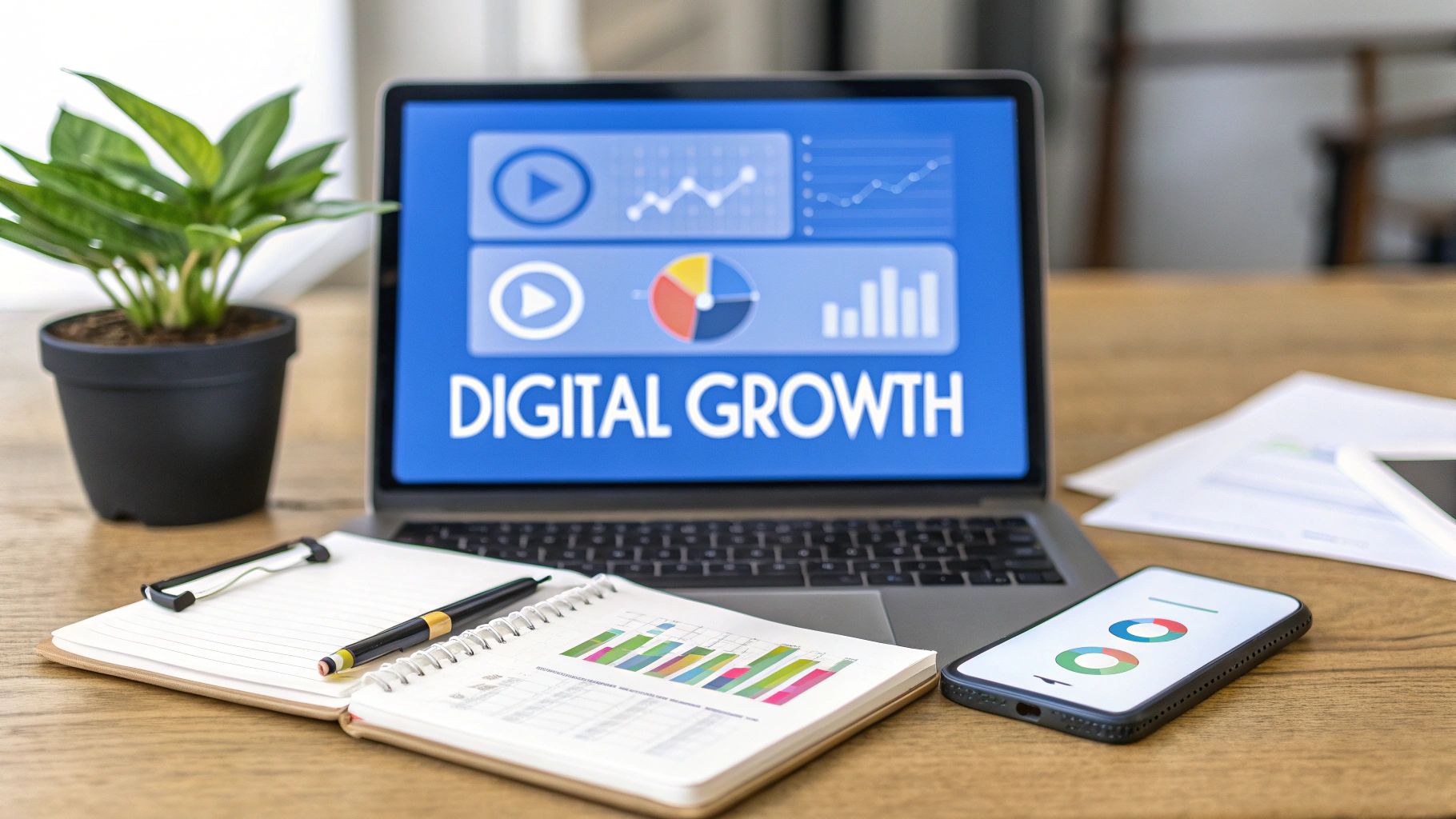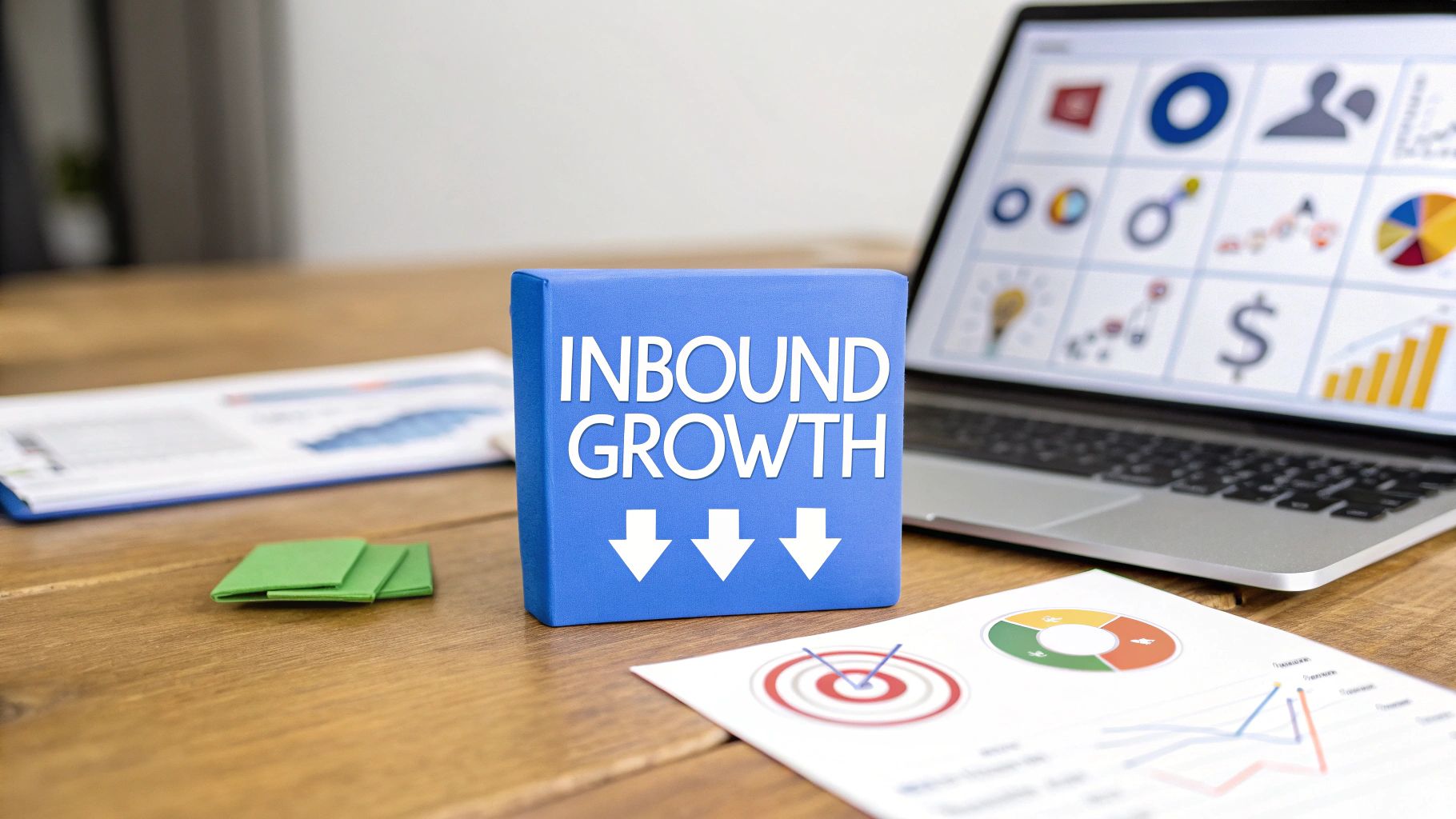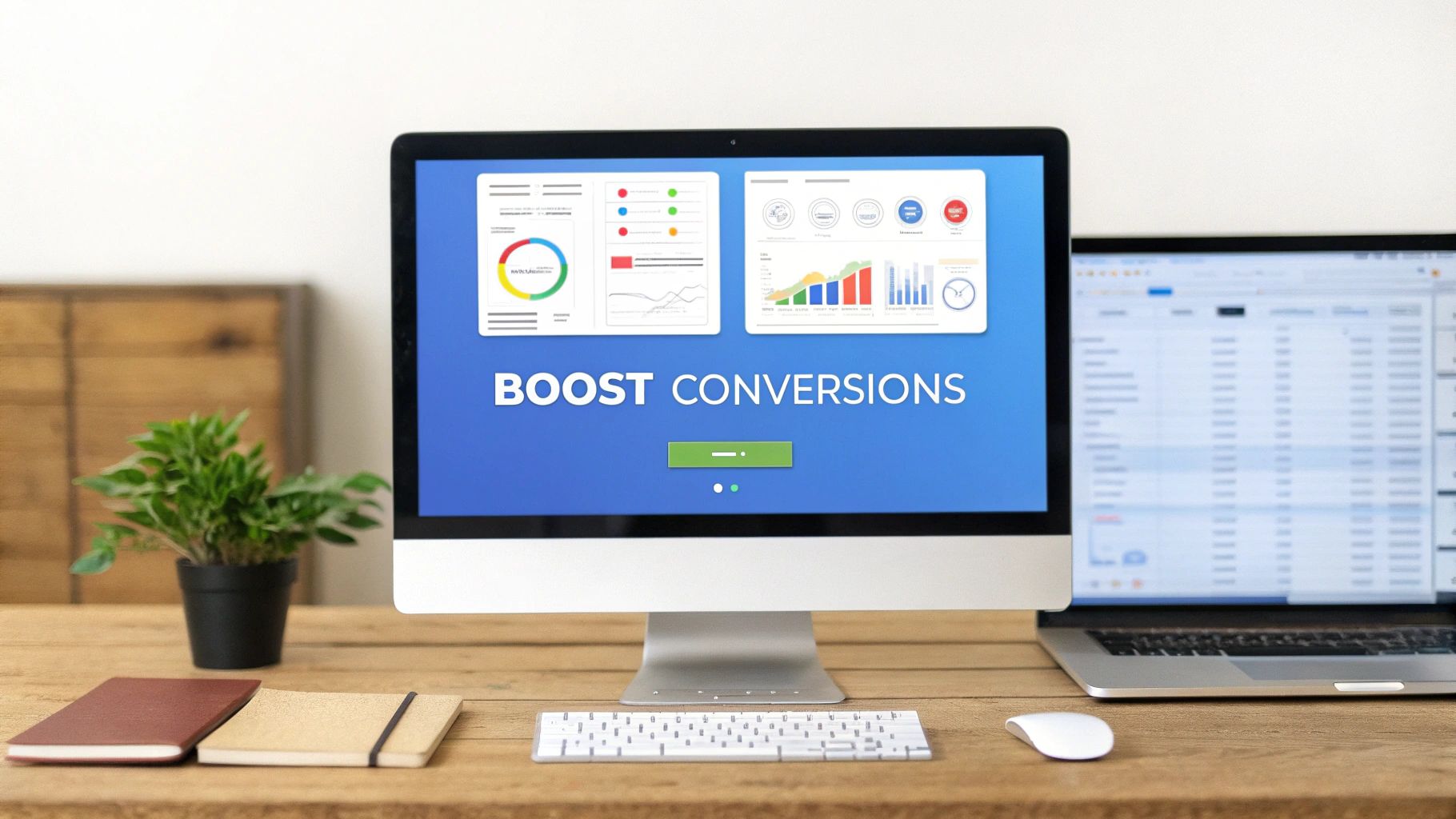Summary
Meta Description: Supercharge your growth with these 7 essential digital marketing tips for small businesses. Learn local SEO, content, social media, and more to win in 2025.
In today's competitive market, a strong online presence isn't just an advantage—it's a necessity. But for small business owners juggling a dozen tasks, digital marketing can feel like a complex, ever-changing puzzle. Where do you even begin? This guide cuts through the noise, providing a clear roadmap to success.
We've compiled practical and powerful small business digital marketing tips you can implement right away to attract more customers, build lasting relationships, and drive real growth. Forget generic advice; these are actionable strategies designed for maximum impact, even with limited resources. We will cover critical areas like Local SEO, content strategy, and social media engagement.
This playbook breaks down exactly what you need to do, step-by-step, to see tangible results. We will explore how to automate your email marketing, manage customer reviews effectively, and optimize for the mobile experience that your customers expect. For additional insights and strategies to kickstart your growth, consider these 7 essential small business digital marketing tips for 2025 as a complementary resource. Are you ready to transform your online strategy from a source of stress into your most powerful growth engine? Let's dive in.
1. Master Your Backyard: Dominate with Local SEO
Local SEO is your secret weapon for attracting high-intent customers right in your neighborhood. It's the practice of optimizing your online presence to appear in local search results, like Google Maps and the 'near me' searches that customers perform every day. For a small business, this isn't just about visibility; it's about connecting with the people most likely to walk through your door or book your service. By focusing on local signals, you can effectively compete with larger businesses in your specific geographic area.
Why is Local SEO a Must-Use Digital Marketing Tip?
Think about it: when someone searches for "best coffee shop near me" or "plumber in [Your Town]," they are ready to buy. Appearing in the coveted Google "Local Pack" (the map and three listings at the top of the search results) puts your business directly in front of these motivated customers. It levels the playing field, allowing your local expertise and proximity to outshine a national chain's massive marketing budget.
How to Get Started with Local SEO for Your Business
Putting this powerful small business digital marketing tip into action involves a few key steps. Start by claiming and fully optimizing your free Google Business Profile (GBP). This is the cornerstone of your local presence.
- Complete Your Profile: Fill out every single section of your GBP. Add high-quality photos of your business, list your services and products, and ensure your hours are always accurate.
- Standardize Your NAP: Your business Name, Address, and Phone number (NAP) must be consistent across your website, GBP, and all other online directories like Yelp and Angie's List. Inconsistencies can confuse search engines and harm your ranking.
- Gather Customer Reviews: Actively encourage happy customers to leave reviews on Google and other relevant platforms. Positive reviews build trust and are a significant local ranking factor.
- Create Local Content: Write blog posts or create landing pages about local events, news, or topics relevant to your service area. For example, a roofer in Dallas could write a post titled "How to Prepare Your Roof for Texas Hail Season."
Pro Tip: Responding to all reviews, both positive and negative, shows Google and potential customers that you are engaged and value feedback. This simple action can significantly boost your local authority.
To truly 'Master Your Backyard' and dominate local search, dive into our comprehensive ultimate guide to local SEO for small businesses for an even deeper look at advanced strategies and optimization techniques.
2. Become the Expert: Build Trust with Content Marketing
Content marketing is the art of creating and sharing valuable, relevant, and consistent content to attract and retain a specific audience. It's not about directly selling your products or services; it's about establishing your business as a trusted authority. For small businesses, this strategy builds a loyal community by providing genuine solutions to your audience's problems through blog posts, videos, guides, and social media updates.
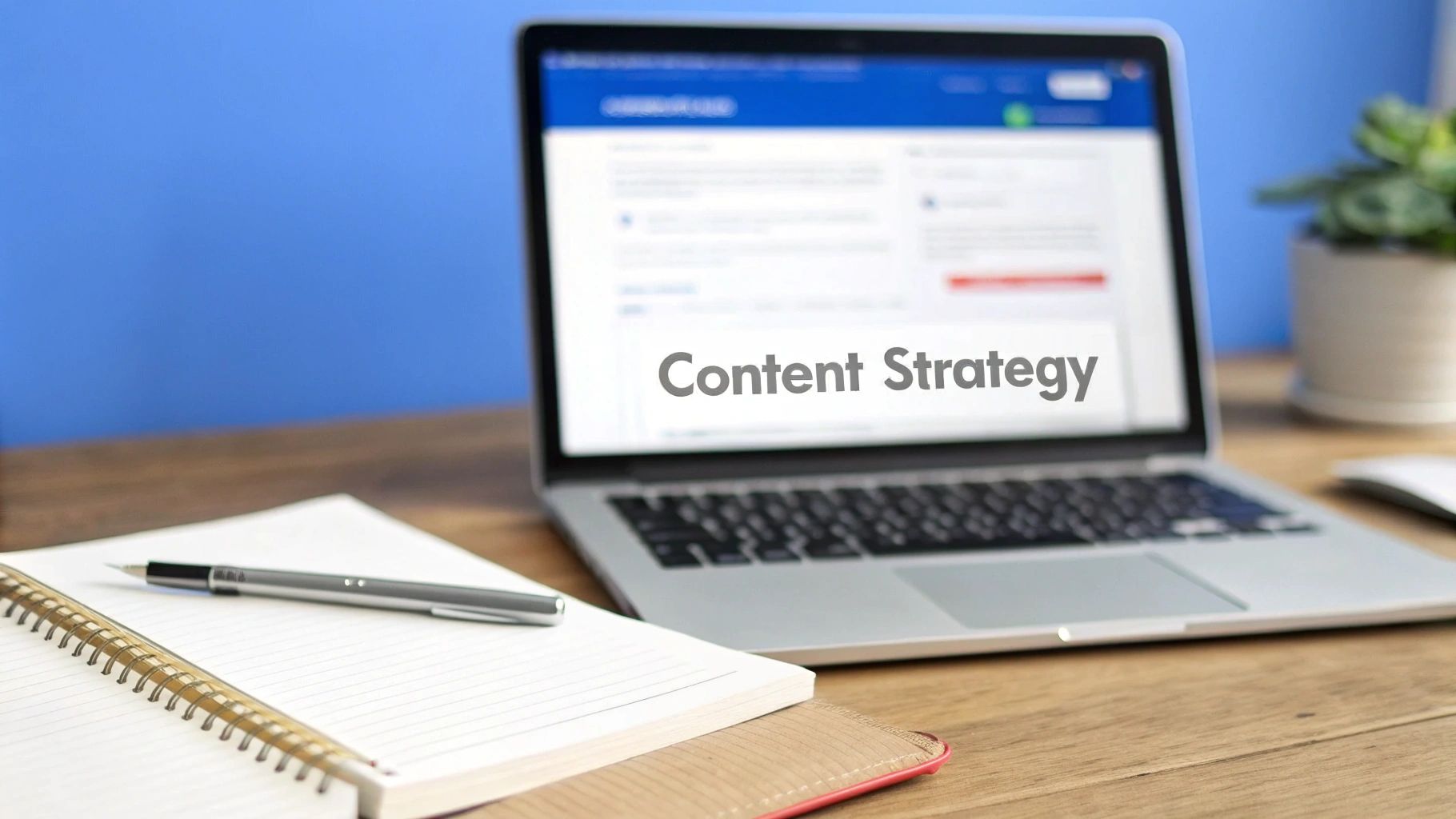
Why is Content Marketing a Must-Use Digital Marketing Tip?
Instead of interrupting potential customers with ads, you are providing them with content they are actively searching for. This approach builds trust and rapport long before they are ready to make a purchase. When they do need your product or service, your business will be the first one they think of. This is one of the most effective small business digital marketing tips because it generates organic traffic, nurtures leads, and creates brand advocates without a massive advertising budget.
How to Get Started with a Content Marketing Plan
Putting this powerful strategy into action means becoming a go-to resource for your ideal customer. You can start small and build momentum by focusing on quality over quantity.
- Solve Customer Problems: Brainstorm the top 10 questions you receive from customers. Turn each answer into a detailed blog post, a short video, or a helpful social media graphic. This ensures your content is immediately relevant.
- Pick One Channel First: Don't try to be everywhere at once. Start with one format you're comfortable with, like a blog or a YouTube channel, and master it before expanding.
- Repurpose Your Winners: Once you have a high-performing blog post, turn it into a video, an infographic, a series of tweets, and a podcast segment. This maximizes your effort and reaches different audience segments.
- Analyze and Adapt: Use tools like Google Analytics to see which topics resonate most with your audience. Double down on what works and create more content around those popular themes.
Pro Tip: Consistency is more important than frequency. Whether you decide to publish new content daily, weekly, or bi-weekly, stick to a predictable schedule. This trains your audience to look forward to your content and tells search engines your site is active and valuable.
To learn more about building a foundation of trust, check out this guide on creating a content strategy from the Content Marketing Institute.
3. Build a Community with Social Media Marketing
Social media marketing involves using platforms like Instagram, Facebook, and LinkedIn to connect with your target audience, build your brand identity, and drive sales. For a small business, it's an invaluable tool for direct, authentic communication with customers. It provides a platform to showcase your brand's personality, share your story, and build a loyal community around your products or services.

Why is Social Media a Must-Use Digital Marketing Tip?
In today's digital landscape, having a social media presence is non-negotiable. It’s where your customers are spending their time, discovering new brands, and making purchasing decisions based on peer recommendations and authentic content. It allows you to engage in real-time conversations, gather immediate feedback, and humanize your brand in a way that traditional advertising simply can't match. This direct line of communication builds trust and fosters long-term customer loyalty.
How to Get Started with Social Media Marketing
Diving into social media doesn't have to be overwhelming. The key is to be strategic and consistent. Start by identifying where your ideal customers spend their time online and focus your efforts there, rather than trying to be on every platform at once.
- Choose Your Platforms Wisely: Don't spread yourself too thin. Pick 2-3 platforms that best align with your brand and audience. For example, a local bakery might thrive on visual platforms like Instagram and Facebook, while a B2B consultant will find more value on LinkedIn.
- Plan Your Content: Create a simple content calendar to ensure you're posting consistently. Mix up your content with promotions, behind-the-scenes looks, educational tips, and user-generated content to keep your audience engaged.
- Engage Authentically: Social media is a two-way street. Respond to comments and messages promptly. Ask questions and create polls to encourage interaction. Genuine engagement is more valuable than just broadcasting your message.
- Use Platform-Specific Features: Leverage tools like Instagram Stories, Reels, and Facebook Live to create dynamic and timely content. These features are often favored by platform algorithms, increasing your organic reach.
Pro Tip: Focus on metrics that truly impact your business, like website clicks, leads, and conversions, rather than just vanity metrics such as likes and followers. This data will tell you what's actually working and help you refine your strategy.
Building an engaged online community is one of the most effective small business digital marketing tips for sustainable growth. To dive deeper, check out this guide on creating a social media strategy.
4. Work Smarter, Not Harder: Adopt Email Marketing Automation
Email marketing automation is the engine that drives your customer relationships on autopilot. It involves using software to send personalized, timely emails to subscribers based on specific triggers or their journey with your brand. For a small business, this is a game-changer, allowing you to nurture leads, onboard new customers, and recover lost sales without dedicating hours to manual email sends. It transforms your email list from a simple broadcast tool into a dynamic, responsive communication channel.
Why is Email Automation a Must-Use Digital Marketing Tip?
Imagine being able to automatically send a welcome series to every new subscriber, a special discount on their birthday, or a reminder about items left in their shopping cart. That's the power of automation. It ensures no customer falls through the cracks and that your communication is always relevant. This level of personalization builds stronger customer loyalty and significantly increases conversion rates, allowing you to generate revenue 24/7. It’s one of the most efficient small business digital marketing tips for scaling your efforts effectively.
How to Get Started with Email Marketing Automation
Implementing this powerful strategy is more accessible than you might think. The key is to start small with a clear goal in mind and build from there. Begin by choosing an email marketing platform with automation features, such as Mailchimp, ConvertKit, or ActiveCampaign.
- Launch a Welcome Series: Your first automation should be a simple 3-5 email welcome sequence for new subscribers. Use it to introduce your brand, set expectations, and offer a small incentive to make a first purchase.
- Segment Your Audience: Group your subscribers based on their interests, purchase history, or how they joined your list. This allows you to send highly targeted content that resonates, rather than one-size-fits-all messages.
- Recover Abandoned Carts: For e-commerce businesses, this is a must. Set up an automated email that goes out a few hours after a customer leaves items in their cart, reminding them to complete their purchase.
- Provide Consistent Value: Automate educational content or tips related to your industry. This positions you as an expert and keeps your brand top-of-mind, even when customers aren't ready to buy.
Pro Tip: Keep your automated emails feeling personal. Use merge tags to include the subscriber's first name, and write your copy in a conversational, human tone. Automation should be efficient, not robotic.
To truly harness the potential of this strategy, explore our guide on how to get started with marketing automation for small businesses and discover advanced techniques to grow your company.
5. Pay-Per-Click (PPC) Advertising for Instant Visibility
Pay-Per-Click (PPC) advertising is a powerful way to get your business in front of customers at the exact moment they are searching for your products or services. Platforms like Google Ads allow you to place ads at the top of search results, and you only pay when someone actually clicks your ad. This model provides immediate visibility and highly targeted traffic, making it a fantastic tool for small businesses needing quick results and a direct line to motivated buyers.
Why is PPC a Must-Use Digital Marketing Tip?
While SEO is a long-term strategy, PPC delivers speed and precision. Need to promote a seasonal sale or a new service right now? A PPC campaign can be live in hours, driving traffic to your website instantly. It allows you to compete for valuable keywords and top search positions, even against larger companies with established organic rankings. This makes it one of the most effective small business digital marketing tips for generating leads and sales on demand.
How to Get Started with PPC Advertising
Getting started with PPC requires a strategic approach to ensure your budget is used effectively. Success isn't just about paying for clicks; it's about paying for the right clicks that lead to conversions.
- Start Small and Scale: You don't need a massive budget. Begin with a modest daily amount to test keywords, ad copy, and audience targeting. Once you identify what works, you can confidently scale your investment.
- Utilize Negative Keywords: Add negative keywords to your campaigns to prevent your ads from showing for irrelevant searches. For example, a plumber offering "emergency repairs" should add "jobs" and "training" as negative keywords to avoid wasting money on unqualified clicks.
- Write Compelling Ad Copy: Your ad is your first impression. It needs a strong headline, clear benefits, and a compelling call-to-action (CTA) like "Get a Free Quote Today" or "Shop Our Sale Now."
- Optimize Your Landing Page: The click is just the beginning. Ensure the landing page your ad links to is relevant, easy to navigate, and designed to convert visitors into customers.
Pro Tip: Regularly monitor your campaign performance. Pay close attention to metrics like Click-Through Rate (CTR) and Conversion Rate. Don't be afraid to pause underperforming ads and reallocate your budget to the campaigns that are driving real results.
To truly maximize your return on investment and build a high-performing campaign, explore our in-depth guide to optimizing your Google Ads campaigns for advanced strategies and expert insights.
6. Build Unshakable Trust: Proactive Customer Review Management
Customer review management is the process of actively monitoring, responding to, and leveraging customer feedback across various online platforms. For small businesses, this practice is a cornerstone of digital marketing because reviews are the modern-day word-of-mouth, profoundly influencing both potential customers and search engine rankings. It's about taking control of your online reputation to build trust, credibility, and a loyal customer base.
Why is Review Management a Must-Use Digital Marketing Tip?
In today's digital landscape, a staggering 93% of consumers read online reviews before making a purchase. This feedback directly impacts your bottom line. Positive reviews act as powerful social proof, reassuring potential customers and encouraging them to choose you over a competitor. Furthermore, platforms like Google use review quantity, velocity, and quality as significant ranking factors for local search, meaning a strong review profile can boost your visibility right when customers are looking for your services.
How to Get Started with Customer Review Management
Implementing a proactive review management strategy is one of the most impactful small business digital marketing tips you can action today. The goal is to create a positive feedback loop that attracts new customers while providing insights to improve your business.
- Claim Your Listings: Ensure your business is listed and claimed on key review sites for your industry, such as Google, Yelp, Facebook, and any niche-specific platforms. This gives you control over your information and the ability to respond.
- Actively Request Reviews: Don't just wait for reviews to happen. Systematically ask satisfied customers to share their experience. A simple follow-up email or a text message with a direct link can dramatically increase your review volume.
- Respond Promptly and Professionally: Aim to respond to all reviews, both positive and negative, within 24-48 hours. Thank customers for positive feedback and address negative comments by acknowledging the issue and offering a solution offline.
- Showcase Your Best Feedback: Leverage your positive reviews as marketing assets. Display them prominently on your website, share them on social media, and include them in email newsletters to build social proof.
Pro Tip: Use the insights gathered from customer reviews as free market research. Recurring complaints or praises can highlight exactly where you need to improve your products, services, or customer experience.
Effectively using reviews is a powerful form of social proof that can dramatically increase conversions. To see how top brands leverage this, explore these compelling social proofing examples and get inspired to turn your customer feedback into a marketing engine.
7. Adopt a Mobile-First Mindset for Today's User
Mobile-first optimization is the practice of designing your digital presence for the smallest screen, a mobile device, and then adapting the design for larger screens like desktops. With Google now primarily using the mobile version of a site for indexing and ranking, a seamless mobile experience is no longer optional. For a small business, this approach ensures you effectively capture and convert the ever-growing number of users who discover, research, and purchase from their phones.
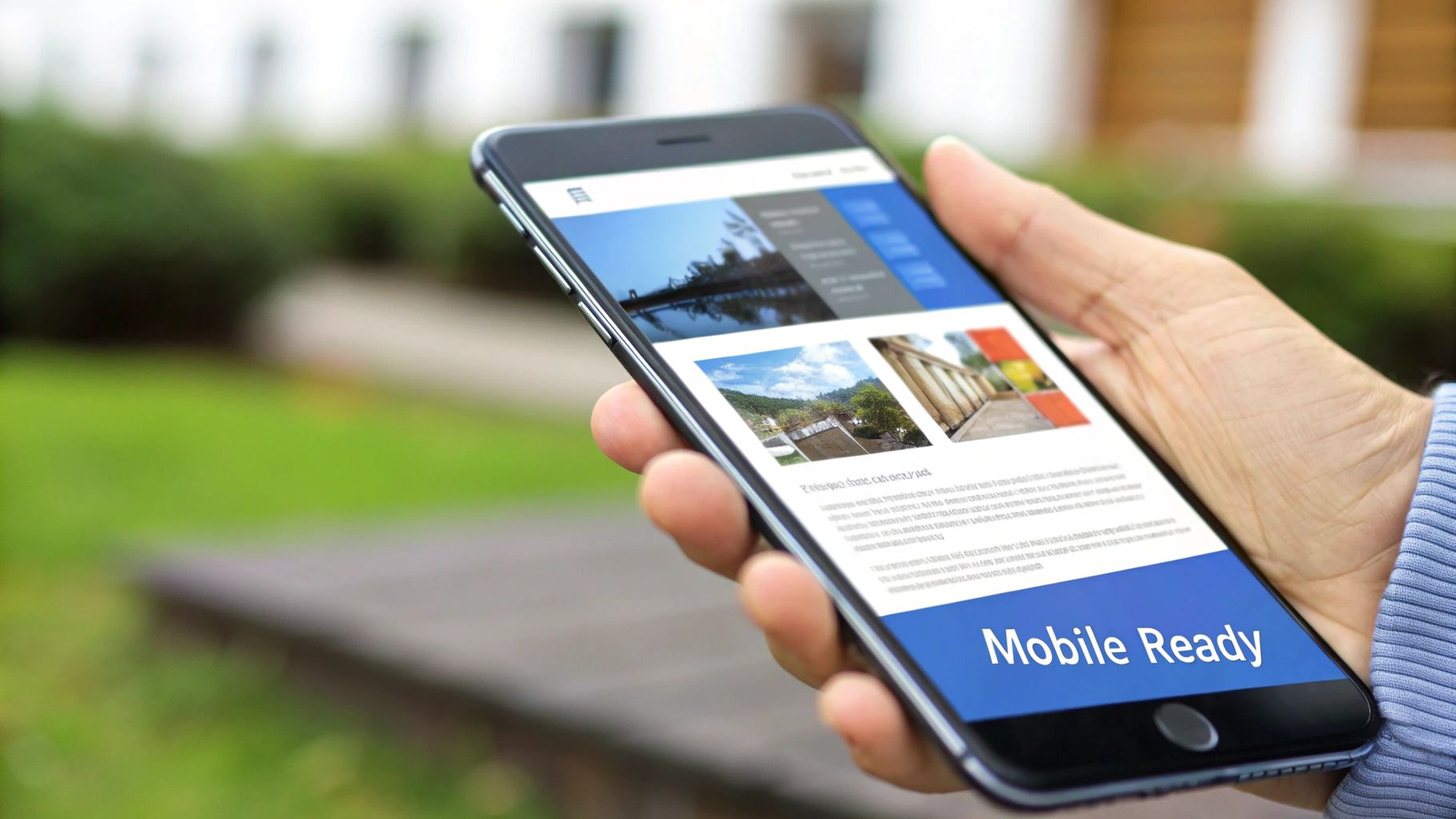
Why is Mobile-First a Must-Use Digital Marketing Tip?
Consider this: over 60% of all online searches now happen on a mobile device. If your website is slow to load, difficult to navigate with a thumb, or forces users to pinch and zoom, you are actively turning away potential customers. A mobile-first strategy directly impacts your bottom line by reducing bounce rates, improving user engagement, and boosting conversions. It is a critical component of any modern set of small business digital marketing tips.
How to Get Started with Mobile-First Optimization
Transitioning to a mobile-first approach involves prioritizing speed, simplicity, and accessibility on small screens. The goal is to provide an effortless experience for users on the go, from initial discovery to final purchase.
- Test Your Current Site: Use Google's free Mobile-Friendly Test to get an instant analysis of your site's performance on mobile devices. This provides a clear baseline and actionable feedback.
- Prioritize for Speed: Optimize images, leverage browser caching, and minimize code to ensure your pages load in under three seconds. Slow load times are a primary reason visitors abandon a site.
- Design for Thumbs: Ensure buttons and links are large enough and spaced appropriately for easy tapping. Place key navigation elements and calls-to-action (CTAs) within easy reach of a user's thumb.
- Streamline Everything: Simplify your navigation, shorten your forms, and make sure your most important information is visible without scrolling. A restaurant, for instance, should have its "Order Online" button and phone number prominently displayed at the top.
Pro Tip: Think beyond just your website. Ensure your emails are mobile-responsive and your digital ads are designed to look great on a phone screen. Every digital touchpoint should be optimized for the mobile user journey.
7 Essential Digital Marketing Tips Comparison
Your Next Step: Turn These Tips into Action
You have just navigated a comprehensive roadmap of powerful digital marketing strategies, each one capable of transforming how your small business connects with customers and drives growth. From dominating local search results to building a loyal community on social media, the path forward is clearer than ever. We've demystified the essentials, breaking down complex topics like SEO, PPC, and email automation into manageable, actionable components.
The sheer volume of information can feel overwhelming, but remember this: progress over perfection. The goal is not to implement all seven of these small business digital marketing tips by tomorrow. The real goal is to choose one, commit to it, and execute it with excellence. Your journey to digital mastery is a marathon, built on consistent effort and strategic adjustments.
Recapping Your Digital Marketing Toolkit
Let's quickly revisit the core pillars we've covered. These are not just isolated tactics; they are interconnected parts of a holistic growth engine:
- Local SEO Optimization: Your key to becoming the go-to choice for customers in your immediate area. It's about being visible when and where it matters most.
- Content Marketing: The foundation of trust and authority. By providing value upfront, you create an audience that sees you as an expert, not just a vendor.
- Social Media Marketing: Your direct line to building relationships. This is where your brand’s personality shines, fostering a community that advocates for you.
- Email Marketing Automation: The workhorse of your marketing efforts. It nurtures leads, engages customers, and drives repeat business while you focus on other tasks.
- Pay-Per-Click (PPC) Advertising: The accelerator for your growth. PPC offers immediate visibility and highly targeted traffic, delivering measurable results quickly.
- Customer Review Management: Your modern-day word-of-mouth. Positive reviews build social proof and directly influence purchasing decisions.
- Mobile-First Optimization: A non-negotiable standard. Ensuring a seamless experience on mobile devices is crucial for capturing and retaining a massive segment of your audience.
Turning Knowledge into Tangible Results
The most significant barrier to success isn't a lack of knowledge; it's a failure to act. The true value of these small business digital marketing tips is only unlocked through implementation. Start by identifying your biggest bottleneck. Are you struggling to get foot traffic? Focus on Local SEO. Do you need leads right now? Launch a targeted PPC campaign.
Key Takeaway: The most impactful strategy is the one you start today. Choose the tip that best aligns with your most pressing business goal and dedicate your resources to mastering it. Once it’s running smoothly, move on to the next.
This incremental approach creates momentum. Each small win builds upon the last, gradually constructing a robust digital presence that works tirelessly for your business. By consistently applying these principles, you will not only reach your target audience but also build lasting relationships that fuel sustainable growth for years to come. Your digital future is in your hands; it's time to build it.
Ready to maximize the return on your ad spend and turn more clicks into customers? Many of these strategies, especially PPC, drive traffic to your website, but a high-converting landing page is what seals the deal. Discover how LanderMagic can help you create stunning, optimized landing pages in minutes, ensuring your marketing efforts lead to real revenue. Build Your First High-Converting Page with LanderMagic.



